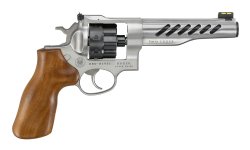If you want to shoot revolver competitions, 9mm makes a lot of sense. You're probably going to use moonclips anyway for easier reloads, so the fact that 9mm requires moonclips isn't a big deal.
The short case means more positive ejection and less misalignment when loading. And 9mm is cheap and generally shoots pretty well.
The shorter cylinder is lighter which means less trigger effort required to turn it--which can make a difference in rapid fire.
It's not something that interests me right now, but I can see how it might appeal to some folks.
The short case means more positive ejection and less misalignment when loading. And 9mm is cheap and generally shoots pretty well.
The shorter cylinder is lighter which means less trigger effort required to turn it--which can make a difference in rapid fire.
It's not something that interests me right now, but I can see how it might appeal to some folks.

